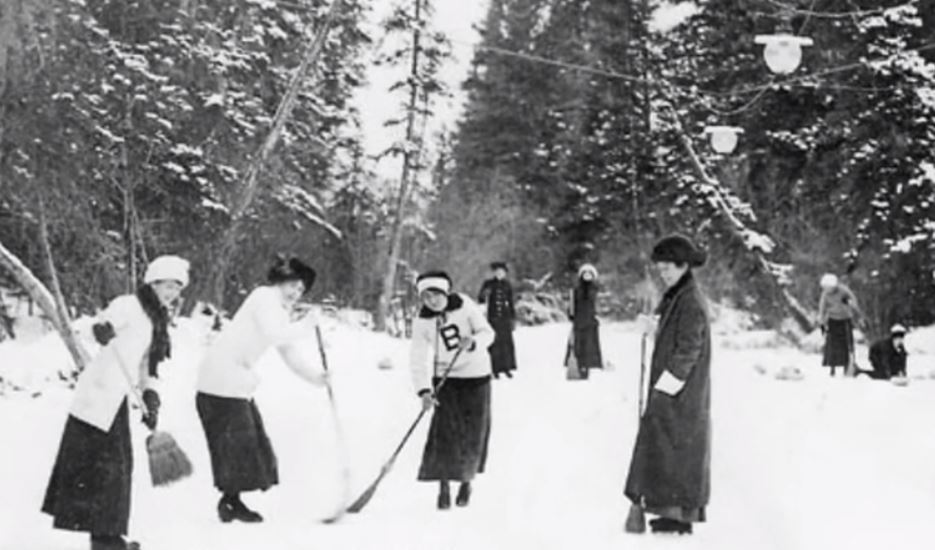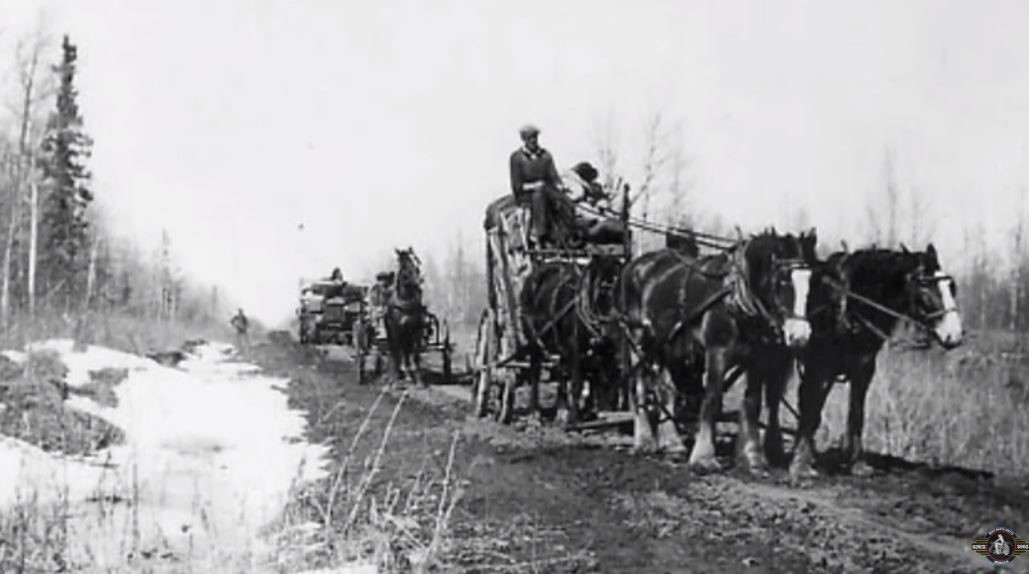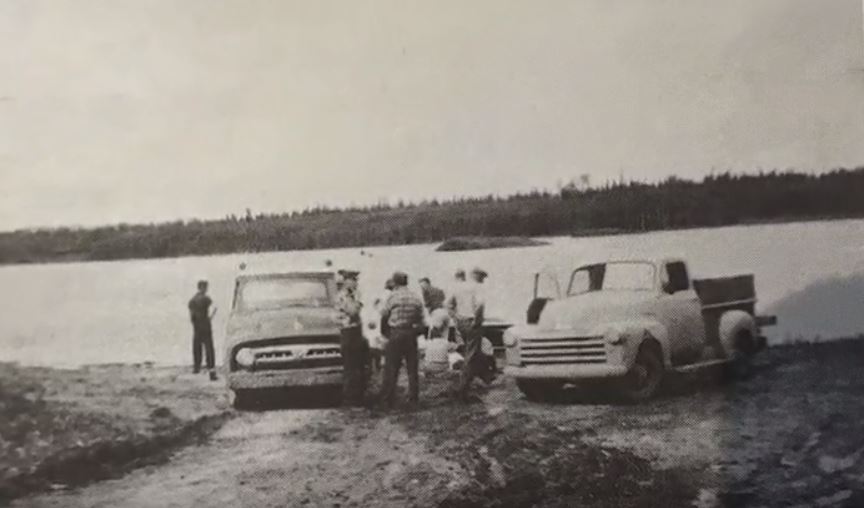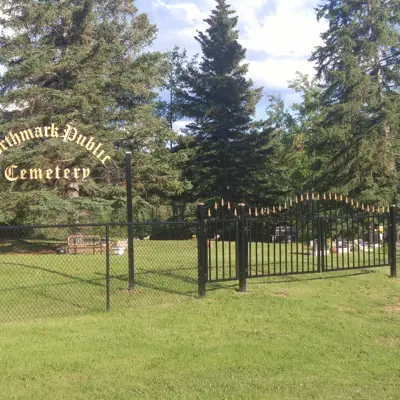The Northwest Territory, the area we know today as the Peace River Country, is far older than the counties, provinces, and the country known as Canada. The land itself is home to a diversity of fauna, with elk, moose, deer, and black bear being particularly attractive to hunters to this day. The beaver population is also seeing a resurgence as the consequences of the fur trade in the 19th and 20th centuries are remedied.1
Due to the abundance of beaver in the area, the 'Beaver Tribe' was the name given by European settlers to the people of the Dane-zaa First Nations. According to oral histories, Saddle Hills County and the surrounding area was the traditional homeland of the Dane-zaa, but they were driven north of the Peace River by the Plains Cree, who were absorbing territory in their westward migration.
Following the North American smallpox epidemic which struck the Cree peoples in 1781, a peace treaty was arranged between the two warring peoples, which identified the land north of the river as Dane-zaa territory, while the Cree held the land south of the river. This is how the Peace River was given its name. A ceremonial pipe was smoked in celebration at Dunvegan, and the river was deemed a space for the two peoples to meet and trade.2 Despite this, according to Henry Somers Somerset's testimony, “The Land of the Muskeg,” an animosity remained between the two tribes.3
On July 6, 1899, Natooses, a leader of the Dane-zaa, agreed to the terms of Treaty 8 with Commissioners James Ross and J.A. McKenna. The Commissioners completed a tour of the Northwest Territory to create adhesions to the Treaty for other First Nations in the area. However, much of the Spirit River area was missed, and J.A. Mcrae was sent by the crown to complete these adhesions, and in 1900 the Canadian government declared the area open for development.4
The area was a hub for European traders, missions, settlers, and companies as well. The Northwest Company, The Hudson's Bay Company, and the Revillon Brothers all had operations along the river, connecting the small settler communities that formed in the area.5 The fur trade was the first major industry to establish itself in the region, and has become a part of Alberta's history of staples economies.
The B.C. gold rushes also brought prospectors north to pan the vast river system of the northwest.6 The Oblate Fathers of the St. Charles Roman Catholic Mission established a mission at Fort Dunvegan in 1867 to convert Aboriginal populations to their faith, but as those populations dwindled at the turn of the 20th century, the mission moved south to the Spirit River area.7
The 1872 Dominion Lands Act allowed settlers to buy 160 acres of land in the west for a $10 fee.8 There are records of settlers occupying the land that would become Spirit River as early as 1892, but plans formally establishing a settlement began in 1907.9
History
Saddle Hills County is a diverse, rural community with a rich local history. The County originated on April 1, 1945, and was the combination of several small Improvement Districts (I.D.) into I.D. #134. This was later renumbered to I.D. #20 on January 1, 1969. The I.D. was incorporated and became the Municipal District (M.D.) of Saddle Hills #20 in January 1995. It was finally incorporated as Saddle Hills County, on July 1, 1999.
Saddle Hills County as we know it today, spans across 5,838.15 km2. It is defined by its northern border along the Peace River, shared with Clear Hills County, its western border with British Columbia, the eastern border, shared with the M.D. of Fairview, the M.D. of Spirit River #133, and Birch Hills County, and its southern border, shared with the County of Grande Prairie #1.
The Central Peace Region is a large area spanning many modern Towns and Counties, and because of the vast geography and nature of settlement, the communities in the area share a rich, interconnected regional history. Much of this history has been collected as journals, transcriptions of oral histories, family stories, and photographs.
The 20th Century: Trials and Tribulations
The first two decades of the 20th century were vital in the development of communities in Peace River Country. Alberta joined confederation in 1905, and the First World War ravaged the European continent. The area had been settled before this time, but a combination of veterans returning from the war, European immigrants fleeing an increasingly unstable political climate, the increasing price of land in southern Alberta, rising domestic and American interests in the inexpensive lands, and the continued construction of the railroads brought a flood of new homesteaders into Peace River Country.
The railway passenger cars (nicknamed “colonist cars”) brought waves of European settlers from the coast into Peace River Country, many of them of Ukrainian and German origin. It is these many European communities that helped build the region's Orthodox, Roman Catholic, and Lutheran communities, among others.10

To this day, the area is home to a diverse range of religious communities because of this history. Rail was only one method of travel into the region though, with many settlers arriving by horse-drawn wagons or automobiles. As a result of this growth in population, many of the old log structures built by past settlers were repurposed for use as schools and community halls, as was the case at Blueberry Mountain.11
Settlers would supplement their ranching and agricultural pursuits with hunting and setting trap lines. Lumbering operations cropped up as well, with the Buffalo Lakes Lumber Company Ltd. near Woking being one of the first in the area.12 As well as providing materials for houses in the area, the lumbering operations and sawmills shipped product east and south, energizing the economy in the area, and continuing the tradition of Alberta as a staples economy.
Access to healthcare at this time was limited. People relied on traveling dentists, and Dr. Reavely of Spirit River was the only doctor servicing the entire area until the mid-thirties. The fetching of Dr. Reavely to aid women in labour was so ubiquitous that it would later be re-enacted in parades.13
In 1920, a local named Mrs. Binkley ran a small hospital out of her residence with her two daughters, starting out with only two beds. Three other small hospitals began operating in the 1930's, two out of private residences, the third out of the Old Imperial Bank building.14
In 1941, the Grey Nuns arrived from Ottawa and established the Holy Cross Hospital in Spirit River, providing doctors and patients with up-to-date facilities and equipment. The Sisters served the area in their hospital until their departure in the 1970's, from which point on healthcare service was provided by the government, which built the Central Peace General Hospital in the 1960's.15
Though the region was devastated by the Great Depression of the 1930's, with the hunting and trapping that was once supplementary becoming necessary for subsistence for many families, the region recovered and prospered into the 1940's with the spread of oil and gas extraction in the region.16
This industry remains vital to the County to this day. Oil and Gas operations are a prominent feature throughout the entire county. Presently, the land south of the Highway 49 is predominantly used by oil and gas operations. Just as the Second World War was ending, on April 1st, 1945, the smaller townships and I.D.s of the area joined to form I.D. 134.
Following the Second World War, the government opened the Silver Valley area to new homesteaders, clearing many acres of land for new settlers.17 This encouraged many people to leave the Grande Prairie and Spirit River areas to start new ventures. Friends would tell each other about new land they had acquired near the Spirit River, the word of mouth prompting even more migration to the area. 
The arrival of the telephone companies to the area contributed to this as well. Conversation and debate around the issue began in the 1950's, and by the early 1960's, three companies were established in the area: The Burnt River Rural Mutual Telephone Company, the Saddle Mountain Mutual Telephone Company, and Westmark Mutual Telephone Co.18 In 1970, telecom was taken over by the provincially owned Alberta Government Telephones (AGT), prompting the three companies in the area to dissolve.
Logging, oil and gas, and farming continued to be the driving forces in the local economy in the post-war era. Following the strikes and pickets of the 1930's, the workers of the area began forming clubs, unions, and other community groups. In the workplace, this facilitated negotiation and representation as opposed to the direct action, but outside the workplace, these organizations fostered community engagement, hosting events like dances and pie socials.19
The UFA and other large unions and workers' organizations were active in the area at this time as well. The UFA existed as a lobbying group and then as a political party, but its main function to the people of the area was community organization and service provision through their cooperatives.20
4-H has been very active in the area, starting a variety of agriculture, ranching, and cultural clubs throughout the post-war decades.21 Many of these clubs resemble the 4-H clubs that exist today, teaching young people how to raise livestock through hands on learning. One club of note was the 4-H Clothing Club, which taught young women home economics and etiquette.22
The club became inactive some time in the 1970's. Today, the active 4-H clubs are the Savanna multi-club, the Woking multiclub, the New Horizons multi-club, and the Eaglesham beef club.23 The organization remains active in the area to this day.
Many smaller clubs worked to shape their communities as well. The Silver Valley Busy Bees was a ladies' club which raised funds through raffles, potlucks, and other events, eventually raising $200 to construct a new community hall.24
The Horseshoe of the Peace Historical Society hosted informational events and compiled a local history book. The Fourth Creek Junior Forest Wardens and The Girl Forest Guards were groups dedicated to teaching youths about environmental conservation and survival skills.
As well as formal groups, loose organization of families and interest have been vital to the health and community, forming many of the sports teams in the area (mainly baseball and hockey), and providing swimming lessons at Moonshine Lake, among other activities.25 
By this time, travel by automobile had become more and more common, and the state of the roads and trails had become an impediment for many. Most roads were trails worn out in the dirt, and ditches were not dug in until the 1960's.26
To this day, dust control and road maintenance is a vital part of the operation of the County. In 1960, the Dunvegan Bridge was completed, replacing the Dunvegan Ferry, which had been active since 1909, and connecting traffic between Alaska and the southern US border. This bridge was the first highway suspension bridge in the prairies, and continues to facilitate travel across the Peace River.
In the late 1970's, plans began on establishing 6,500 acres of grazing land in the north of Township 80. This area was developed by the Silver Slope Co-op into the Blueberry Mountain Provincial Grazing Reserve, an open pasture as well as a popular site for hunting moose and bear.27
The combination of hunting, farming, logging, and oil and gas in the area creates significant risk of fire. In 1981, I.D. No. 20 built its first fire hall in Woking, continuing to build more across the district throughout the 1980's.
The Municipal District of Saddle Hills No. 20 was incorporated on January 1, 1995, composed of ranges in townships numbered between 75 and 84, all of this land “lying west of the sixth meridian.”29 On July 1, 1999, the county was renamed, along with several other counties. The “No. 20” was removed, and the county received its current name, “Saddle Hills County.”30
1 Signage and Displays, Alberta Historical Resources Foundation, Dunvegan Provincial Park, Dunvegan AB.
2 Jim Ferguson, “Immigration of the Cree,” in Chepi Sepe (Spirit River): The Land- The People, (Spirit River, AB, Spirit River History Book Committee, 1989), 7.
3 Somers Somerset, “The Land of the Muskeg,” in Chepi Sepe (Spirit River), 7.
4 Signage and Displays, Alberta Historical Resources Foundation.
5 Ibid.
6 Burnt Embers: A History of Woking and District in the Burnt River Valley, (Woking, AB, Woking and Area Historical Society, 1985), 8. 7 Signage and Displays, Alberta Historical Resources Foundation.
8 Burnt Embers, 11-12.
9 Ann Hagerty, “The History of the Spirit River Settlement,” in Chepi Sepe (Spirit River), 13.
10 Burnt Embers, 13-14.
11 Helen (Reeves) Morrison, “Chester Reeves and Family,” in The Big Bend (Blueberry Mountain, AB: Big Bend Historical Committee, 1981), 88.
12 Burnt Embers, 30.
13 Ibid, 59.
14 “Medical Facilities,” in Chepi Sepe (Spirit River), 144-151.
15 Ibid, 59.
16 Ibid, 26, 57-58.
17 Denise Derksen, “Aron and Jessie Derksen,” in The Big Bend, 172.
18 Burnt Embers, 92-93.
19 Ibid, 95-98.
20 Ibid.
21 Ibid, 99-102.
22 Ibid.
23 Karene, Moira. Interviewed by Chase Coli. Phone Interview. May 09, 2019.
24 Tales, Trails, & Gumbo: Cotillon, Silver Valley, Fourth Creek, (Spirit River, AB: Horseshoe of The Peace Historical Society, 1991), 14.
25 Ibid, 42-49.
26 George Rempel, “The Bill Rempel Family,” in The Big Bend, 189. 27 Alan Taylor, “Blueberry Mountain Provincial Grazing Reserve,” in, Tales, Trails, and Gumbo, 25.
28 Betty Phillips, “Health Services 1970-1990,” in Tales, Trails, & Gumbo, 28.
29 Canada, Alberta, Ministry of Municipal Affairs, Order in Council O.C. 755/94.
30 Canada, Alberta, Ministry of Municipal Affairs, Order in Council O.C. 265/99.
Original text and research completed by Chloe Crisanti, May 9, 2019.
Burnt Embers: A History of Woking and District in the Burnt River Valley. Woking, AB: Woking and Area Historical Society, 1985.
The Big Bend. Blueberry Mountain, AB: Big Bend Historical Committee, 1981.
Chepi Sepe (Spirit River): The Land- The People. Spirit River, AB: Spirit River History Book Committee, 1989.
Tales Trails & Gumbo: Cotillon, Silver Valley, Fourth Creek. Spirit River, AB: Horseshoe of The Peace Historical Society, 1991.
Canada. Alberta. Ministry of Municipal Affairs. Order in Council O.C. 755/94.
Canada. Alberta. Ministry of Municipal Affairs. Order in Council O.C. 265/99.
Karene, Moira. Interviewed by Chase Coli. Phone Interview. May 09, 2019.
“Saddle Hills County.” https://townfolio.co/ab/saddle-hills-county/. Accessed May 05, 2019.
Signage and Displays. Alberta Historical Resources Foundation; Government of Alberta, Dunvegan Provincial Park, Dunvegan AB. Accessed May 05, 2019.
More Information:
Contact Us
Saddle Hills
Junction of Hwy 49 & Secondary Hwy 725
RR1, Spirit River AB
T0H 3G0
T. 780-864-3760
Fax 780-864-3904
Toll-free 1-888-864-3760
frontdesk@saddlehills.ab.ca
Sign up to our Newsletter
Stay up to date on the Saddle Hills activities, events, programs and operations by subscribing to our eNewsletters.




